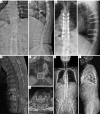Minimally invasive prone lateral retropleural or retroperitoneal antepsoas approach spinal surgery using the rotatable radiolucent Jackson table
- PMID: 39816780
- PMCID: PMC11732327
- DOI: 10.21037/jss-24-71
Minimally invasive prone lateral retropleural or retroperitoneal antepsoas approach spinal surgery using the rotatable radiolucent Jackson table
Abstract
Background: Prone lateral spinal surgery for simultaneous lateral and posterior approaches has recently been proposed to facilitate surgical room efficiency. The purpose of this study is to evaluate the feasibility and outcomes of minimally invasive prone lateral spinal surgery using a rotatable radiolucent Jackson table.
Methods: From July 2021 to June 2023, a consecutive series of patients who received minimally invasive prone lateral spinal surgery for various etiologies by the same surgical team were reviewed. A Mizuho Jackson Modular Table System was used for all prone lateral surgeries. All patients received combined lateral and posterior approach surgery on the same day. The lateral approaches were performed with the Jackson table rotated 30-40 degrees away from the surgical side. A table-mounted oblique lumbar interbody fusion (OLIF) retractor was applied in retropleural/retroperitoneal spaces. Minimally invasive lateral procedures such as discectomy or mini-open corpectomy were performed after adequate exposure. Posterior procedures were performed with the Jackson table rotated back horizontally. The disease etiologies, surgical levels, blood loss, operation time, and surgical procedures were collected and analyzed.
Results: The study included 64 patients with a mean age of 61.8 years (range, 26-88 years). The disease etiologies were 11 (17.2%) deformities, 15 (23.4%) degenerations, 25 (39.1%) infections, 9 (14.1%) traumas, and 4 (6.3%) tumors. The mean length of the surgical level was 4.1±2.0 (range, 2-10), with surgical levels ranging from T8 to L5 laterally and T6 to the ilium posteriorly. The mean blood loss was 863±843 mL (range, 50-4,600 mL) and the mean operation time was 314±148 minutes (range, 92-785 minutes). Of the lateral approaches, there were 25 retropleural and 39 retroperitoneal approaches (36 antepsoas approach). Surgical procedures performed included lateral discectomies, mini-open corpectomies, interbody reconstruction and fusion, and various posterior techniques such as pedicle screw instrumentation, cement augmentation, decompression, osteotomy, and spinal endoscopy. Patients who received both prone lateral retropleural and retroperitoneal approaches had significant improvement in the sagittal Cobb angle of the lateral surgical level, Visual Analogue Scale (VAS), and Oswestry Disability Index (ODI) at 1 year postoperatively.
Conclusions: Minimally invasive prone lateral spinal surgery is a feasible option for patients requiring combined lateral and posterior approach spinal surgery. Both lateral retropleural and retroperitoneal antepsoas approaches can be applied in combination with various posterior surgical procedures in the prone position using the rotatable radiolucent Jackson table.
Keywords: Prone lateral spinal surgery; retroperitoneal antepsoas approach; retropleural approach.
2024 AME Publishing Company. All rights reserved.
Conflict of interest statement
Conflicts of Interest: All authors have completed the ICMJE uniform disclosure form (available at https://jss.amegroups.com/article/view/10.21037/jss-24-71/coif). The authors have no conflicts of interest to declare.
Figures







References
LinkOut - more resources
Full Text Sources
